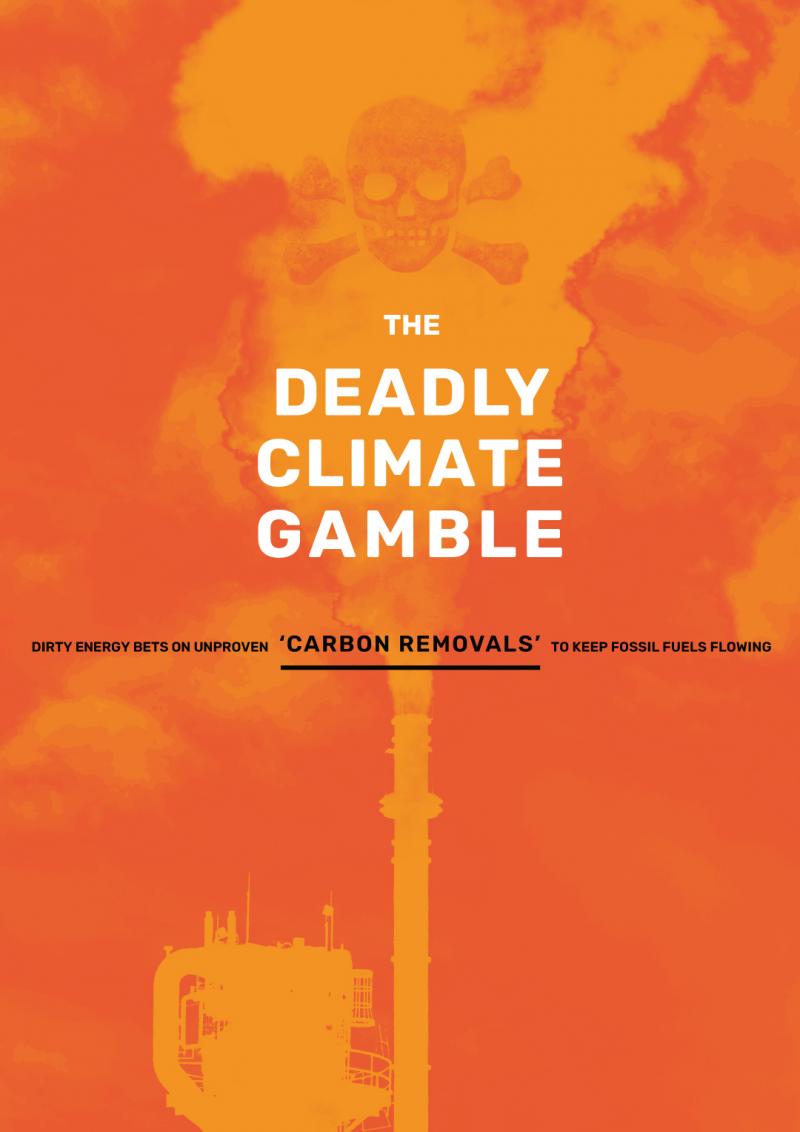
The deadly climate gamble
Dirty Energy bets on unproven ‘carbon removals’ to keep fossil fuels flowing
The EU is aiming to reach climate neutrality – or ‘net zero’ – by 2050, which, in reality, means the talk about reducing emissions remains just that... talk. ‘Net zero’ is based on the concept that continued emissions can be ‘balanced’ by the removal of carbon from the atmosphere, through offsetting, capturing, or removing CO2, and it’s gained acceptance thanks to the lobbying of dirty energy giants. Fossil fuel companies that want a free pass to keep pumping oil and gas are making wildly unrealistic promises about 'capturing' their emissions at sites of pollution, or removing them from the atmosphere at later date. But the science says drastic emission cuts are needed now if we are to stay within 1.5ºC warming. Thus ‘net zero’ policies are in reality 'not zero', and effectively guarantee that we’ll overshoot 1.5ºC, triggering catastrophic climate impacts which we have no reason to believe can be reversed by speculative and unproven ‘carbon removal’ technologies.
To shed light on how the ‘net zero’ con works at the EU level this report, published by Corporate Europe Observatory in collaboration with nine civil society groups, analyses the responses from an array of fossil fuel companies – such as Equinor, Eni, Repsol, and Shell – and their lobby groups, to the Commission’s autumn 2021 public consultation on restoring sustainable carbon cycles, and its spring 2022 consultation on the certification of carbon removals. These responses show that the oil and gas industry is using the excuse of ‘carbon removal’ as a way to keep the fossil fuels flowing. Dirty energy giants are fully on board with the Commission’s plans, and are using the carbon removal agenda to get yet more support for carbon capture, utilisation and storage (CCUS), which is a key component of the pie-in-the-sky carbon removal technologies being promoted by the Commission. But more support for the staggeringly costly, failed technology of CCUS not only means more fossil fuel extractivism, it is also a dangerous distraction from real solutions to address the climate crisis in a just way, starting with the rapid phase out of fossil fuels and the just and sustainable scaling-up of clean renewable energies like wind and solar to reach 'real zero'.
The Commission is preparing new rules for the certification of carbon removals, due to be published by the end of November 2022. This new regulatory framework would be the basis for creating carbon removal certificates that could be traded as ‘offsets’ in a carbon removals market. Offsetting, simply put, means a polluter can pay someone else to do something meant to help the climate – but carbon offset markets have a track-record of fuelling human rights abuses such as land grabs, and of failing to reduce emissions. Despite this, offsetting is a big part of many oil and gas companies’ ‘net zero’ pledges, which tend to give pride of place to CCUS, alongside plans to ‘compensate’ their continued (or increased) fossil emissions with dubious and damaging nature-based offsets or speculative carbon removal technologies. This flawed approach will be strengthened by the EU’s carbon removal certification, which is likely to help increase the number and credibility of problematic offsets in both voluntary and compliance carbon markets, while allowing overall emissions to rise.
Key findings
1- The fossil fuel industry used the consultations to lobby for massive support for CCUS, including a broad CO2 transport and storage network. This lobby was successful as shown in the final communication. The communication directly supports CCUS by funneling more public money into carbon capture, utilisation and storage infrastructure, providing more regulatory support and creating an annual forum that puts industry in the driving seat. Put plainly, the Commission is saying yes to years of lobby demands from the fossil fuel industry.
CCUS is also a key piece in the grand hydrogen hype. EU hydrogen plans include ‘blue’ hydrogen made using fossil gas, with the promise (always in the future) that CCUS will capture and store emissions.
2- Oil and gas companies are pushing for yet more public support for CCUS, including as a key component of problematic carbon removal technologies (because the infrastructure needed for CCUS are prerequisites for BECCS and DACCS, speculative carbon removal technologies via bioenergy or direct air capture). For the fossil fuel industry, carbon removals are a sure-fire route to get CCUS back on the table.
3- Dirty energy giants such as Eni, Vattenfall, Equinor, IOGP, and Eurogas are pushing weak voluntary industry standards as the basis for carbon removals certification. This is a common lobbying tactic for big business to avoid regulatory oversight. This is a sure-fire route to getting ‘removals’ certified even though they do not remove carbon from the atmosphere and cannot ‘offset’ real emissions. Equinor also suggests limits on transparency, saying public disclosure should only be done “sufficiently and appropriately” – a dangerous move that could undermine public accountability.
The Commission is putting industry in the driving seat, including through its Carbon capture, utilisation and storage Forum. The next meeting of the group, now a permanent fixture, will be in October 2022. Despite pretensions to portray it as a multi-stakeholder body it is heavily dominated by fossil fuel industry groups. This is reflected in the draft paper vision on CCUS that the Forum is preparing for DG Energy and that reads as an industry wish-list.
4- The oil and gas lobby is pushing for an EU carbon removals market, potentially expanding the EU Emissions Trading System. Certificates for carbon removals could be used as tradeable offsets. This would multiply the dangers from existing carbon offset markets, which already fuel carbon colonialism, land grabs, and human rights abuses.
Read the full report here.
